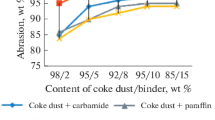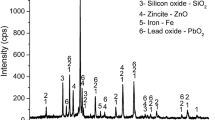Samples of briquettes based on dust from electric arc furnace production with various organic and mineral binders have been obtained. The study of the dependence of the ultimate strength during briquettes compression on the type of binders and their amount in the samples, testing of samples for dropping and abrasion, as well as the study of the chemical composition of samples of reduced briquettes have been carried out. The phase, chemical and granulometric compositions of the electric arc furnace dust have been preliminary investigated, the values of the optimum moisture content required to create briquettes with the highest mechanical characteristics have been determined.






Similar content being viewed by others
References
E. P. Bol’shina, Ecology of Metallurgical Production: Course of Lectures [in Russian], NF NITU MISIS, Novotroitsk (2012).
Z. S. Gel’manova and D. M. Zhaksybaev, “Features of the formation and use of secondary resources in metallurgical production,” Mezhdunar. Zh. Prikl. Fundam. Issled., No. 7 - 5, 749 - 753 (2016).
I. E. Doronin and A. G. Svyazhin, “Industrial methods of steelmaking dust processing,” Metallurg, No. 10, 48 - 53 (2010).
M. Omran and T. Fabritius, “Utilization of blast furnace sludge for the removal of zinc from steelmaking dusts using microwave heating,” Sep. Purif. Technol., 210, 867 - 884 (2019).
X. L. Liu, Z. J. Liu, J. L. Zhang, and X. D. Xing, “Recovery of iron and zinc from blast furnace dust using iron-bath reduction,” High Temp. Mater. Proc., 38(1), 767 - 772 (2019).
V. B. Dobrokhotov, M. A. Abramov, and E. G. Stepanov, “Complex utilization of dust-like waste from metallurgical production facilities,” Vestn. Rybinsk. Gos. Aviats. Tekhnol. Akad., No. 4, 96 - 101 (2020).
GOST 22733-2016, Soils. Laboratory Method for Determining Maximum Density [in Russian], Izdatel’stvo Standartov, Moscow (2019).
GOST 25471-82, Iron Ores, Concentrates, Agglomerates and Pellets. Method for Determining Drop Strength [in Russian], IPK Izdatel’stvo Standartov, Moscow (2004).
GOST 26136-84, Iron Ores, Concentrates, Agglomerates and Pellets. Method of Sampling and Preparation of Samples for Physical Tests [in Russian], Izdatel’stvo Standartov, Moscow (1984).
Author information
Authors and Affiliations
Corresponding author
Additional information
Translated from Novye Ogneupory, pp. 42-47, No. 10, October, 2021.
Rights and permissions
About this article
Cite this article
Kozaev, A.A., Khabibulin, E.E., Khaidarov, B.B. et al. Study of the Influence of the Binder Composition on the Mechanical Characteristics of Dust Briquettes from Electric Arc Furnace Production. Refract Ind Ceram 62, 587–592 (2022). https://doi.org/10.1007/s11148-022-00646-4
Received:
Published:
Issue Date:
DOI: https://doi.org/10.1007/s11148-022-00646-4




